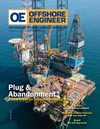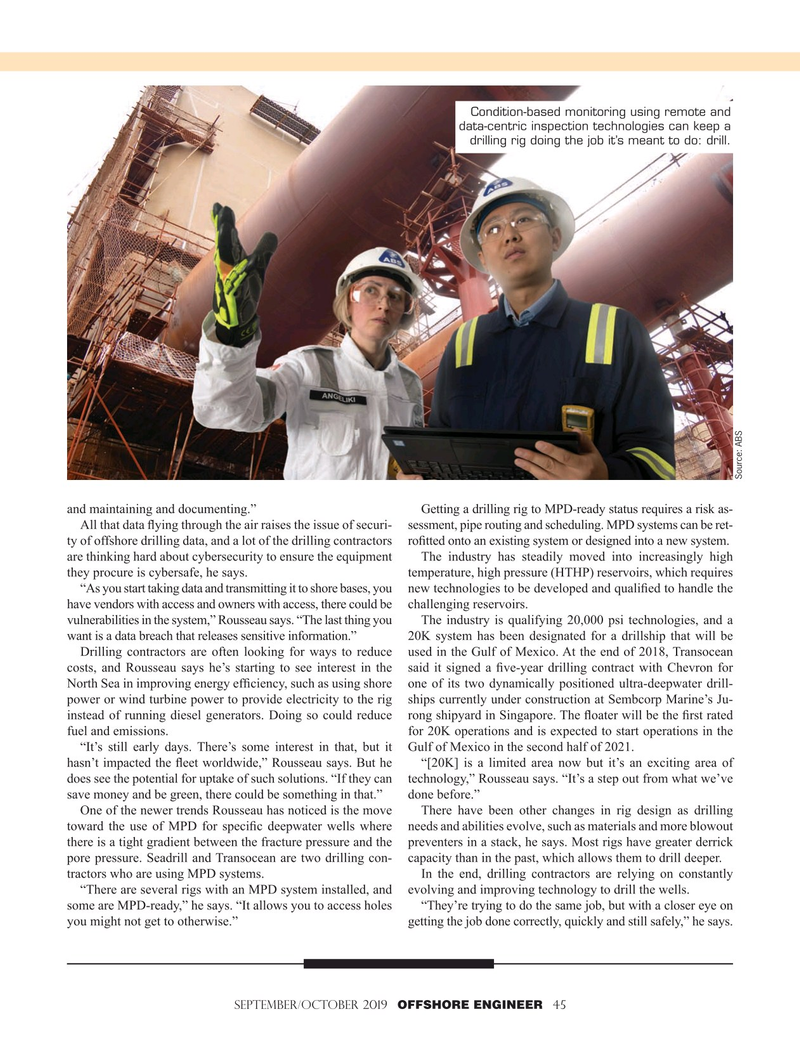
Page 45: of Offshore Engineer Magazine (Sep/Oct 2019)
Big Data and Digitalization
Read this page in Pdf, Flash or Html5 edition of Sep/Oct 2019 Offshore Engineer Magazine
Condition-based monitoring using remote and data-centric inspection technologies can keep a drilling rig doing the job it’s meant to do: drill.
Source: ABS and maintaining and documenting.” Getting a drilling rig to MPD-ready status requires a risk as-
All that data ? ying through the air raises the issue of securi- sessment, pipe routing and scheduling. MPD systems can be ret- ty of offshore drilling data, and a lot of the drilling contractors ro? tted onto an existing system or designed into a new system.
are thinking hard about cybersecurity to ensure the equipment The industry has steadily moved into increasingly high they procure is cybersafe, he says. temperature, high pressure (HTHP) reservoirs, which requires “As you start taking data and transmitting it to shore bases, you new technologies to be developed and quali? ed to handle the have vendors with access and owners with access, there could be challenging reservoirs.
vulnerabilities in the system,” Rousseau says. “The last thing you The industry is qualifying 20,000 psi technologies, and a want is a data breach that releases sensitive information.” 20K system has been designated for a drillship that will be
Drilling contractors are often looking for ways to reduce used in the Gulf of Mexico. At the end of 2018, Transocean costs, and Rousseau says he’s starting to see interest in the said it signed a ? ve-year drilling contract with Chevron for
North Sea in improving energy ef? ciency, such as using shore one of its two dynamically positioned ultra-deepwater drill- power or wind turbine power to provide electricity to the rig ships currently under construction at Sembcorp Marine’s Ju- instead of running diesel generators. Doing so could reduce rong shipyard in Singapore. The ? oater will be the ? rst rated fuel and emissions. for 20K operations and is expected to start operations in the “It’s still early days. There’s some interest in that, but it Gulf of Mexico in the second half of 2021.
hasn’t impacted the ? eet worldwide,” Rousseau says. But he “[20K] is a limited area now but it’s an exciting area of does see the potential for uptake of such solutions. “If they can technology,” Rousseau says. “It’s a step out from what we’ve save money and be green, there could be something in that.” done before.”
One of the newer trends Rousseau has noticed is the move There have been other changes in rig design as drilling toward the use of MPD for speci? c deepwater wells where needs and abilities evolve, such as materials and more blowout there is a tight gradient between the fracture pressure and the preventers in a stack, he says. Most rigs have greater derrick pore pressure. Seadrill and Transocean are two drilling con- capacity than in the past, which allows them to drill deeper. tractors who are using MPD systems. In the end, drilling contractors are relying on constantly “There are several rigs with an MPD system installed, and evolving and improving technology to drill the wells.
some are MPD-ready,” he says. “It allows you to access holes “They’re trying to do the same job, but with a closer eye on you might not get to otherwise.” getting the job done correctly, quickly and still safely,” he says.
SEPTEMBER/OCTOBER 2019 OFFSHORE ENGINEER 45

 44
44

 46
46